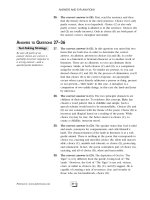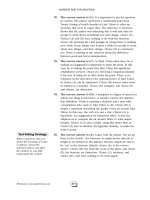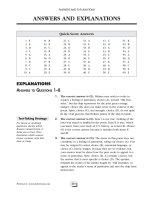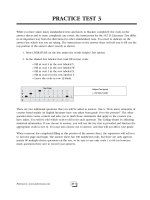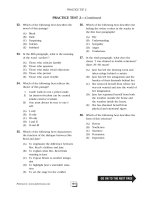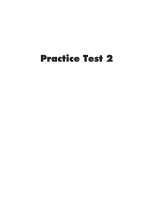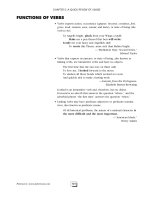SAT II Physics (SN) Episode 2 Part 2 potx
Bạn đang xem bản rút gọn của tài liệu. Xem và tải ngay bản đầy đủ của tài liệu tại đây (1.67 MB, 25 trang )
simply the product of the current and the resistance. The voltage drop across the two
resistors is:
Note that the voltage drop across the two resistors is 10 V + 20 V = 30 V, which is the
total voltage drop across the circuit.
Resistors in Parallel
Two resistors are in parallel when the circuit splits in two and one resistor is placed on
each of the two branches.
In this circumstance, it is often useful to calculate the equivalent resistance as if there
were only one resistor, rather than deal with each resistor individually. Calculating the
equivalent resistance of two or more resistors in parallel is a little more complicated than
calculating the total resistance of two or more resistors in series. Given two resistors,
and , in parallel, the equivalent resistance, , is:
When a circuit splits in two, the current is divided between the two branches, though the
current through each resistor will not necessarily be the same. The voltage drop must be
the same across both resistors, so the current will be stronger for a weaker resistor, and
vice versa.
EXAMPLE
Two resistors, = 5 and = 20 , are set up in parallel, as in the diagram above. The
battery produces a potential difference of = 12 V. What is the total resistance in the
circuit? What is the current running through and ? What is the power dissipated in the
resistors?
WHAT IS THE TOTAL RESISTANCE IN THE CIRCUIT?
Answering this question is just a matter of plugging numbers into the formula for
resistors in parallel.
226
So = 4 .
WHAT IS THE CURRENT RUNNING THROUGH R1 AND R2?
We know that the total voltage drop is 12 V, and since the voltage drop is the same across
all the branches of a set of resistors in parallel, we know that the voltage drop across both
resistors will be 12 V. That means we just need to apply Ohm’s Law twice, once to each
resistor:
If we apply Ohm’s Law to the total resistance in the system, we find that = (12 V)/(4 )
= 3 A. As we might expect, the total current through the system is the sum of the current
through each of the two branches. The current is split into two parts when it branches
into the resistors in parallel, but the total current remains the same throughout the whole
circuit. This fact is captured in the junction rule we will examine when we look at
Kirchhoff’s Rules.
WHAT IS THE POWER DISSIPATED IN THE RESISTORS?
Recalling that P = I
2
R, we can solve for the power dissipated through each resistor
individually, and in the circuit as a whole. Let be the power dissipated in , the
power dissipated in , and the power dissipated in .
Note that + = .
Circuits with Resistors in Parallel and in Series
Now that you know how to deal with resistors in parallel and resistors in series, you have
all the tools to approach a circuit that has resistors both in parallel and in series. Let’s
take a look at an example of such a circuit, and follow two important steps to determine
the total resistance of the circuit.
227
1. Determine the equivalent resistance of the resistors in parallel. We’ve
already learned to make such calculations. This one is no different:
So the equivalent resistance is 6 . In effect, this means that the two resistors in parallel
have the same resistance as if there were a single 6 resistor in their place. We can
redraw the diagram to capture this equivalence:
1. Treating the equivalent resistance of the resistors in parallel as a
single resistor, calculate the total resistance by adding resistors in
series. The diagram above gives us two resistors in series. Calculating the total
resistance of the circuit couldn’t be easier:
Now that you’ve looked at this two-step technique for dealing with circuits in parallel and
in series, you should have no problem answering a range of other questions.
EXAMPLE
228
Consider again the circuit whose total resistance we have calculated. What is the current
through each resistor? What is the power dissipated in each resistor?
WHAT IS THE CURRENT RUNNING THROUGH EACH RESISTOR?
We know that resistors in series do not affect the current, so the current through is the
same as the total current running through the circuit. Knowing the total resistance of the
circuit and the voltage drop through the circuit, we can calculate the circuit’s total current
by means of Ohm’s Law:
Therefore, the current through is 3 A.
But be careful before you calculate the current through and : the voltage drop
across these resistors is not the total voltage drop of 30 V. The sum of the voltage drops
across and the two resistors in parallel is 30 V, so the voltage drop across just the
resistors in parallel is less than 30 V.
If we treat the resistors in parallel as a single equivalent resistor of 6 , we can calculate
the voltage drop across the resistors by means of Ohm’s Law:
Now, recalling that current is divided unevenly between the branches of a set of resistors
in parallel, we can calculate the current through and in the familiar way:
WHAT IS THE POWER DISSIPATED ACROSS EACH RESISTOR?
229
Now that we know the current across each resistor, calculating the power dissipated is a
straightforward application of the formula P = I
2
R:
Common Devices in Circuits
In real life (and on SAT II Physics) it is possible to hook devices up to a circuit that will
read off the potential difference or current at a certain point in the circuit. These devices
provide SAT II Physics with a handy means of testing your knowledge of circuits.
Voltmeters and Ammeters
A voltmeter, designated:
measures the voltage across a wire. It is connected in parallel with the stretch of wire
whose voltage is being measured, since an equal voltage crosses both branches of two
wires connected in parallel.
An ammeter, designated:
is connected in series. It measures the current passing through that point on the circuit.
EXAMPLE
In the diagram above, = 9 V, = 5 , = 5 , and = 20 . What are the values
measured by the ammeter and the voltmeter?
WHAT DOES THE AMMETER READ?
Since the ammeter is not connected in parallel with any other branch in the circuit, the
reading on the ammeter will be the total current in the circuit. We can use Ohm’s Law to
determine the total current in the circuit, but only if we first determine the total
resistance in the circuit.
230
This circuit consists of resistors in parallel and in series, an arrangement we have looked
at before. Following the same two steps as we did last time, we can calculate the total
resistance in the circuit:
1. Determine the equivalent resistance of the resistors in parallel.
We can conclude that = 4 .
1. Treating the equivalent resistance of the resistors in parallel as a
single resistor, calculate the total resistance by adding resistors in
series.
Given that the total resistance is 9 and the total voltage is 9 V, Ohm’s Law tells us that
the total current is:
The ammeter will read 1 A.
WHAT DOES THE VOLTMETER READ?
The voltmeter is connected in parallel with and , so it will register the voltage drop
across these two resistors. Recall that the voltage drop across resistors in parallel is the
same for each resistor.
We know that the total voltage drop across the circuit is 9 V. Some of this voltage drop
will take place across , and the rest of the voltage drop will take place across the
resistors in parallel. By calculating the voltage drop across and subtracting from 9 V,
we will have the voltage drop across the resistors in parallel, which is what the voltmeter
measures.
If the voltage drop across is 5 V, then the voltage drop across the resistors in parallel is
9 V – 5 V = 4 V. This is what the voltmeter reads.
Fuses
231
A fuse burns out if the current in a circuit is too large. This prevents the equipment
connected to the circuit from being damaged by the excess current. For example, if the
ammeter in the previous problem were replaced by a half-ampere fuse, the fuse would
blow and the circuit would be interrupted.
Fuses rarely come up on SAT II Physics. If a question involving fuses appears, it will
probably ask you whether or not the fuse in a given circuit will blow under certain
circumstances.
Kirchhoff’s Rules
Gustav Robert Kirchhoff came up with two simple rules that simplify many complicated
circuit problems. The junction rule helps us to calculate the current through resistors in
parallel and other points where a circuit breaks into several branches, and the loop rule
helps us to calculate the voltage at any point in a circuit. Let’s study Kirchhoff’s Rules in
the context of the circuit represented below:
Before we can apply Kirchhoff’s Rules, we have to draw arrows on the diagram to denote
the direction in which we will follow the current. You can draw these arrows in any
direction you please—they don’t have to denote the actual direction of the current. As
you’ll see, so long as we apply Kirchhoff’s Rules correctly, it doesn’t matter in what
directions the arrows point. Let’s draw in arrows and label the six vertices of the circuit:
We repeat, these arrows do not point in the actual direction of the current. For instance,
we have drawn the current flowing into the positive terminal and out of the negative
terminal of , contrary to how we know the current must flow.
The Junction Rule
232
The junction rule deals with “junctions,” where a circuit splits into more than one branch,
or when several branches reunite to form a single wire. The rule states:
The current coming into a junction equals the current coming out.
This rule comes from the conservation of charge: the charge per unit time going into the
junction must equal the charge per unit time coming out. In other words, when a circuit
separates into more than one branch—as with resistors in parallel—then the total current
is split between the different branches.
The junction rule tells us how to deal with resistors in series and other cases of circuits
branching in two or more directions. If we encounter three resistors in series, we know
that the sum of the current through all three resistors is equal to the current in the wire
before it divides into three parallel branches.
Let’s apply the junction rule to the junction at B in the diagram we looked at earlier.
According to the arrows we’ve drawn, the current in the diagram flows from A into B
across and flows out of B in two branches: one across toward E and the other
toward C. According to the junction rule, the current flowing into B must equal the
current flowing out of B. If we label the current going into B as and the current going
out of B toward E as , we can conclude that the current going out of B toward C is –
. That way, the current flowing into B is and the current flowing out of B is + ( –
) = .
The Loop Rule
The loop rule addresses the voltage drop of any closed loop in the circuit. It states:
The sum of the voltage drops around a closed loop is zero.
This is actually a statement of conservation of energy: every increase in potential energy,
such as from a battery, must be balanced by a decrease, such as across a resistor. In other
words, the voltage drop across all the resistors in a closed loop is equal to the voltage of
the batteries in that loop.
In a normal circuit, we know that when the current crosses a resistor, R, the voltage drops
by IR, and when the current crosses a battery, V, the voltage rises by V. When we trace a
loop—we can choose to do so in the clockwise direction or the counterclockwise direction
—we may sometimes find ourselves tracing the loop against the direction of the arrows
233
we drew. If we cross a resistor against the direction of the arrows, the voltage rises by IR.
Further, if our loop crosses a battery in the wrong direction—entering in the positive
terminal and coming out the negative terminal—the voltage drops by V. To summarize:
•
Voltage drops by IR when the loop crosses a resistor in the direction of the
current arrows.
•
Voltage rises by IR when the loop crosses a resistor against the direction of the
current arrows.
•
Voltage rises by V when the loop crosses a battery from the negative terminal to
the positive terminal.
•
Voltage drops by V when the loop crosses a battery from the positive terminal to
the negative terminal.
Let’s now put the loop rule to work in sorting out the current that passes through each of
the three resistors in the diagram we looked at earlier. When we looked at the junction
rule, we found that we could express the current from A to B—and hence the current from
E to D to A—as , the current from B to E as , and the current from B to C—and hence
the current from C to F to E—as – . We have two variables for describing the current,
so we need two equations in order to solve for these variables. By applying the loop rule
to two different loops in the circuit, we should be able to come up with two different
equations that include the variables we’re looking for. Let’s begin by examining the loop
described by ABED.
Remember that we’ve labeled the current between A and B as and the current between
B and E as . Because the current flowing from E to A is the same as that flowing from A
to B, we know this part of the circuit also has a current of .
Tracing the loop clockwise from A, the current first crosses and the voltage drops by
. Next it crosses and the voltage drops by . Then the current crosses , and
the voltage rises by 12 V. The loop rule tells us that the net change in voltage is zero
234
across the loop. We can express these changes in voltage as an equation, and then
substitute in the values we know for , , and :
Now let’s apply the loop rule to the loop described by BCFE.
Tracing the loop clockwise from B, the arrows cross , but in the wrong direction, from
positive to negative, meaning that the voltage drops by 8 V. Next, the current crosses ,
with an additional voltage drop of . Finally, it crosses , but in the opposite
direction of the arrows, so the current goes up by . Now we can construct a second
equation:
Plugging this solution for into the earlier equation of 4 + 3 = 12, we get:
So the current across is 28/13 A. With that in mind, we can determine the current
across and by plugging the value for into the equations we derived earlier:
235
The negative value for the current across means that the current actually flows in the
opposite direction of the arrow we drew. This makes perfect sense when we consider that
current should normally flow out of the positive terminal and into the negative terminal
of battery .
It doesn’t matter how you draw the current arrows on the diagram, because if you apply
Kirchhoff’s Rules correctly, you will come up with negative values for current wherever
your current arrows point in the opposite direction of the true current. Once you have
done all the math in accordance with Kirchhoff’s Rules, you will quickly be able to
determine the true direction of the current.
Capacitors
Capacitors rarely come up on SAT II Physics, but they do sometimes make an
appearance. Because capacitance is the most complicated thing you need to know about
DC circuits, questions on capacitors will usually reward you simply for knowing what’s
going on. So long as you understand the basic principles at work here, you’re likely to get
a right answer on a question most students will answer wrong.
A capacitor is a device for storing charge, made up of two parallel plates with a space
between them. The plates have an equal and opposite charge on them, creating a
potential difference between the plates. A capacitor can be made of conductors of any
shape, but the parallel-plate capacitor is the most common kind. In circuit diagrams,
a capacitor is represented by two equal parallel lines.
For any capacitor, the ratio of the charge to the potential difference is called the
capacitance, C:
For a parallel-plate capacitor, C is directly proportional to the area of the plates, A, and
inversely proportional to the distance between them, d. That is, if the area of the plates is
doubled, the capacitance is doubled, and if the distance between the plates is doubled, the
236
capacitance is halved. The proportionality constant between C and A/d is , called the
permittivity of free space, which we encountered in the previous chapter in relation to
Coulomb’s constant. In case you forgot, C
2
/N · m
2
.
The unit of capacitance is the farad (F). One farad is equal to one coulomb per volt. Most
capacitors have very small capacitances, which are usually given in microfarads, where 1
µF = 10
–6
F.
Energy
To move a small amount of negative charge from the positive plate to the negative plate of
a capacitor, an external agent must do work. This work is the origin of the energy stored
by the capacitor.
If the plates have a charge of magnitude q, the potential difference is . If q = 0,
and work is done to add charge until q = Q, the total work required is:
This is the energy stored by the capacitor. Manipulating this equation and the equation
for capacitance, , we can derive a number of equivalent forms:
Equivalent Capacitance
Like resistors, capacitors can be arranged in series or in parallel. The rule for adding
capacitance is the reverse of adding resistance:
Capacitors in series add like resistors in parallel, and capacitors in parallel add like
resistors in series.
For two capacitors in series:
For two capacitors in parallel:
EXAMPLE
237
Given = 2 µF, = 6 µF, and = 3 µF, what is the total capacitance of the circuit
in the figure above?
First, we find the equivalent capacitance of and . Since they are in parallel, =
+ = 8 µF. Then is given by:
Dielectrics
One way to keep the plates of a capacitor apart is to insert an insulator called a
dielectric between them. A dielectric increases the capacitance. There is an electric field
between the plates of a capacitor. This field polarizes the molecules in the dielectric; that
is, some of the electrons in the molecules move to the end of the molecule, near the
positive plate:
The movement of electrons creates a layer of negative charge by the positive plate and a
layer of positive charge by the negative plate. This separation of charge, in turn, creates
an electric field in the dielectric that is in the opposite direction of the original field of the
capacitor. This reduces the total electric field:
238
The Greek letter is called the dielectric constant, and it varies from material to
material. For all materials, > 1.
For a parallel-plate capacitor, the reduction in E means that is also reduced by a
factor of . Then, since C = Q/ , we find that:
If the potential difference across the capacitor is too large, then the electric field will be so
strong that the electrons escape from their atoms and move toward the positive plate.
This dielectric breakdown not only discharges the capacitor, but also burns a hole in
the dielectric and ruins the capacitor.
Key Formulas
Ohm’s Law
Resistance
Power
Dissipated
in a
Resistor
Heat
Dissipated
in a
Resistor
Equivalent
Resistance
of Two
Resistors
in Series
Equivalent
Resistance
of Two
Resistors
in Parallel
Stored
Energy of a
Capacitor
Equivalent
Capacitanc
e of Two
Capacitors
239
in Series
Equivalent
Capacitanc
e of Two
Capacitors
in Parallel
Practice Questions
The following choices refer to a circuit consisting of a resistor and a battery.
(A) It is doubled
(B) It is quadrupled
(C) It is halved
(D) It is quartered
(E) It remains the same
1. . What happens to the current in the resistor when the voltage is doubled and the resistance
remains the same?
2. . What happens to the power dissipated in the resistor when the resistance is quadrupled
and the voltage remains constant?
3. . Which of the following affects the resistance of a wire?
I. The material from which it is made
II. The length of the wire
III. The diameter of the wire
(A) I only
(B) II only
(C) I and II only
(D) I and III only
(E) I, II, and III
240
4. .
Two resistors, and , are identical, but the potential difference across is half the
potential difference across . What is the ratio of the current in to the current in
?
(A)
(B)
(C) 1
(D) 2
(E) 4
Questions 5 and 6 refer to two identical resistors, arranged in parallel.
5. . If a third identical resistor is added in parallel, what is the ratio of the new equivalent
resistance to the old?
(A)
(B)
(C) 1
(D)
(E)
6. . Assuming the voltage is kept constant, what is the ratio between the new current and the
old current when a third identical resistor is added in parallel with the earlier two?
(A)
(B)
(C) 1
(D)
(E)
241
7. .
How much heat is produced in a 5 resistor in 10 s when a current of 2 A flows through
it?
(A) 2 J
(B) 10 J
(C) 20 J
(D) 100 J
(E) 200 J
8. . Two identical capacitors are arranged in a circuit. What is the ratio of the equivalent
capacitance of the circuit when the capacitors are in series to that when they are in
parallel?
(A)
(B)
(C) 1
(D) 2
(E) 4
9. .
A potential difference of exists between two plates of a parallel-plate capacitor with
capacitance C. A dielectric with a dielectric constant of is then placed between the
plates of the capacitor. What is the energy stored in the capacitor?
(A)
(C/ )( )
2
(B)
( /C)( )
2
(C)
C( )
2
(D)
C
(E)
(C/ )
242
10. . A dielectric is inserted into a capacitor while the charge on it is kept constant. What
happens to the potential difference and the stored energy?
(A) The potential difference decreases and the stored energy increases
(B) Both the potential difference and the stored energy increase
(C) The potential difference increases and the stored energy decreases
(D) Both the potential difference and the stored energy decrease
(E) Both the potential difference and the stored energy remain the same
Explanations
1. A
Ohm’s Law tells us that current and voltage are directly proportional: doubling the voltage will also double
the current.
2. D
The power dissipated in a resistor is given by the formula P = V
2
/R. Since P and R are inversely proportional,
multiplying the resistance by four will divide the power by four.
3. E
The resistance for a wire is given by the formula R = L/A, where is the resistivity of the material the wire
is made of, L is the length of the wire, and A is the cross-sectional area of the wire.
The value of varies from material to material, so the material the wire is made of does affect the resistance
in the wire, which is why we don’t wire our houses with glass or wooden wires. The length of the wire, L, also
affects the resistance, since the longer a wire gets, the farther the electrons in the wire have to travel. The
cross-sectional area, A, and hence the diameter of the wire affects the resistance, since charges have more
room to move in a wider wire. Since all three of the statements are true, the answer is E.
4. B
According to Ohm’s Law, V = IR: current is directly proportional to potential difference. If the potential
difference across is half the potential difference across , and if and have the same resistance,
then the current through is half the current through .
5. B
243
The equivalent resistance, , of two identical resistors in parallel is given by the formula:
The equivalent resistance of three identical resistors in parallel is given by the formula:
The ratio, then, between the new resistance and the old is:
6. D
According to Ohm’s Law, V = IR, current and resistance are inversely proportional. In the previous question,
we saw that the new resistance is
2
/
3
the old resistance. That means that, inversely, the new current is
3
/
2
times the old resistance.
7. E
The power dissipated in a resistor is given by the formula P = I
2
R, which in this case has a value of 20 W. The
heat dissipated in a resistor is given by the formula H = Pt: every second, the resistor dissipates 20 J of
heat. Since we are looking at a 10-second period, the total heat dissipated is 200 J.
8. A
The equivalent capacitance of two capacitors in series is:
244
The equivalent capacitance of two capacitors in parallel is simply the sum of the two capacitors, so =
+ = 2C. The ratio between the equivalent capacitance of the two capacitors in series and the two
capacitors in parallel is therefore:
9. C
The energy stored in a capacitor is . When a dielectric with a dielectric constant of is
inserted between the plates of a capacitor with capacitance C, the new capacitance is C. So (C) is the
correct answer.
10. D
When the dielectric is inserted, the electrons in it create an electric field that opposes the field between the
plates of the capacitor. Since electric field and potential difference are directly proportional, this decrease in
the electric field causes a decrease in the potential difference.
The energy stored in a capacitor is given by the equation , so a decrease in the potential
difference also leads to a decrease in the stored energy.
Magnetism
WHEN WE THINK “MAGNET,” WE MIGHT envision those things we stick on our fridge
door. It may be a bit confusing, then, to discover that magnetism is closely related to
electricity. In fact, there is a single force—the electromagnetic force—that governs the
behavior of both magnets and electric charges.
We have seen that there is a reciprocal relationship between electric charges and electric
fields: electric charges generate electric fields and electric fields exert a force on electric
charges. Similarly, there is a reciprocal relationship between a moving electric charge and
a magnetic field: a moving electric charge creates a magnetic field, and magnetic fields
exert a force on moving charges.
Bearing this reciprocal relationship in mind, we can make sense of electromagnets, the
on-off magnets you see, for instance, lifting and dropping cars at the junkyard. The
magnetism in these electromagnets is generated by a current running through the magnet
that can be turned on and off at will. However, we still haven’t explained how any of this
connects with the permanent magnets we stick to our fridge door.
245
Permanent Magnets
Like all other materials, permanent magnets are made up of atoms that have electrons
orbiting a nucleus of protons and neutrons. In moving around the nucleus, these
electrons create miniscule magnetic fields. In most materials, these tiny fields all point in
different random directions, so the bulk material does not have a magnetic field. But in
permanent magnets, the fields are all lined up together, and so the material is
magnetized. Materials, like iron, that can be magnetized, are called ferromagnetic.
There are two other types of magnetic materials: If a nonferromagnetic material is
attracted by a magnet, it is called paramagnetic. The atoms in an paramagnet line up in
the direction of an external field. If a nonferromagnetic material is repelled by a magnet,
it is called diamagnetic. The atoms in a diamagnet line up against an external field.
Magnetic Field Lines
Permanent magnets—and electromagnets—have positive and negative poles, often called
“north” and “south,” respectively. Like electric field lines, magnetic field lines go from the
positive, or north, pole, toward the negative, or south, pole. For example, the magnetic
field of a bar magnet looks like this:
A horseshoe-shaped magnet creates a magnetic field like this:
It is possible to do a nifty experiment to see these magnetic field lines by scattering iron
fillings around a permanent magnet—the filings will move to trace the lines.
The Earth’s Magnetic Field
246
The Earth itself acts like a huge bar magnet. The presence of a magnetic field about the
Earth allows us to use compasses that point northward, and creates a spectacular aurora
over the northern and southern skies. But the magnetism of the Earth is quite
complicated, and is still an active subject of research for geologists, so let us turn to the
simpler cases of idealized charges and constant magnetic fields.
Magnetic Force on Charges
The questions on magnetism that you’ll find on SAT II Physics will deal for the most part
with the reciprocal relationship between magnetic fields and moving charges. Generally,
these questions will expect you to predict the motion of a charge through a magnetic field,
or to calculate the magnitude of the magnetic force or magnetic field strength necessary
to move a charge in a certain manner.
Calculating Magnetic Force
A magnetic field exerts a force on a moving charge. Given a magnetic field, B, and a
charge, q, moving with velocity, v, the force, F, on the charge is:
Magnetic field strength is measured in teslas (T), where 1 T = 1 N/A · m.
You’ll notice that the force on a moving particle is calculated as a cross product of the
particle’s velocity and the magnetic field’s strength. You can determine the direction of
the vector by using the right-hand rule as follows: point the fingers of your right
hand in the direction of the velocity vector and then curl them around to point in the
direction of the magnetic field vector. The direction in which your thumb points gives you
the direction of the vector.
However, though q is a scalar quantity, it can affect the direction of the force vector. If q
has a negative value, then has a negative value, and so the force vector will point
in a direction opposite from what the right-hand rule might tell you.
You can calculate the magnitude of the magnetic force without using the right-hand rule,
so long as you know the angle, , between the velocity vector and the magnetic field
vector:
The sin term is important, because it lets us see very quickly that there is no force if a
charge moves parallel to a magnetic field, and that the greatest force occurs when a
charge moves perpendicular to the magnetic field.
EXAMPLE
247
A charge of 5 C moves upward at 2 m/s in a magnetic field of 0.3 T that points into the
page. What is the magnitude and direction of the force that the charge experiences?
The cross product of is a vector of magnitude qvB sin = 3 N. Following the right-
hand rule, point your fingers toward the top of the page, and then curl them around so
that they point into the page. You’ll find that your thumb is pointing left, which is the
direction of the vector. Because the value of q is positive, the force acting on the
particle will also be in the leftward direction.
A Quick Note on Vectors Going In and Out of the Page
The magnetic field lines illustrated in this example that are going into the page are
represented by circles with an “x” inscribed in them. Vector lines pointing out of the page
are represented by circles with a dot in them. You can think about these symbols as
arrows appearing from in front or behind: from in front, you see the conical tip of the
arrow, and from behind you see the fletching of the four feathers in an “x” shape.
Trajectory of Charges in a Magnetic Field
The direction of the force on a moving charge depends on the direction of its velocity. As
its velocity changes, so will its direction. The magnitude of the velocity will not change,
but charged particles moving in a magnetic field experience nonlinear trajectories.
When the Velocity Vector and Magnetic Field Lines Are
Perpendicular
In the example above, we saw that a force of 3 N would pull the charged particle to the
left. However, as soon as the particle begins to move, the velocity vector changes, and so
must the force acting on the particle. As long as the particle’s velocity vector is at a right
angle to the magnetic field lines, the force vector will be at right angles to both the
velocity vector and the magnetic field. As we saw in the chapter on circular motion and
gravitation, a force that always acts perpendicular to the velocity of an object causes that
object to move in circular motion.
248
Because the velocity vector and the magnetic field lines are at right angles to one another,
the magnitude of the magnetic force is F = qvB. Furthermore, because the magnetic force
pulls the particle in a circular path, it is a centripetal force that fits the equation F =
mv
2
/r. Combining these two equations, we can solve for r to determine the radius of the
circle of the charged particle’s orbit:
When the Velocity Vector and Magnetic Field Lines Are Parallel
The magnetic force acting on a moving charged particle is the cross product of the
velocity vector and the magnetic field vector, so when these two vectors are parallel, the
magnetic force acting on them is zero.
When the Velocity Vector and Magnetic Field Lines Are Neither
Perpendicular nor Parallel
The easiest way to deal with a velocity vector that is neither parallel nor perpendicular to
a magnetic field is to break it into components that are perpendicular and parallel to the
magnetic field.
The x-component of the velocity vector illustrated above will move with circular motion.
Applying the right-hand rule, we find that the force will be directed downward into the
page if the particle has a positive charge. The y-component of the velocity vector will
experience no magnetic force at all, because it is moving parallel to the magnetic field
lines. As a result, the charged particle will move in a helix pattern, spiraling around while
also moving up toward the top of the page. Its trajectory will look something like this:
If the particle has a positive charge it will move in a counterclockwise direction, and if it
has a negative charge it will move in a clockwise direction.
249
EXAMPLE
A particle of mass kg has a negative charge of –10 C. It moves in a clockwise
circular pattern of radius 2 m at a speed of m/s. What is the magnitude and direction
of the magnetic field acting upon it?
We know the velocity, mass, charge, and radius of the orbit of the particle. These four
quantities are related to magnetic field strength, B, in the equation r = mv/qB. By
rearranging this equation, we can solve for B:
Now we just need to determine the direction of the magnetic field. To find the direction,
apply the right-hand rule in reverse: point your thumb in the direction of the force—
toward the center of the circle—and then stretch your fingers in the direction of the
velocity. When you curl your fingers around, they will point out of the page. However,
because the particle has a negative charge, the magnetic field has the opposite direction—
into the page.
Magnetic Fields and Electric Fields Overlapping
There’s no reason why a magnetic field and an electric field can’t operate in the same
place. Both will exert a force on a moving charge. Figuring out the total force exerted on
the charge is pretty straightforward: you simply add the force exerted by the magnetic
field to the force exerted by the electric field. Let’s look at an example.
EXAMPLE
250
